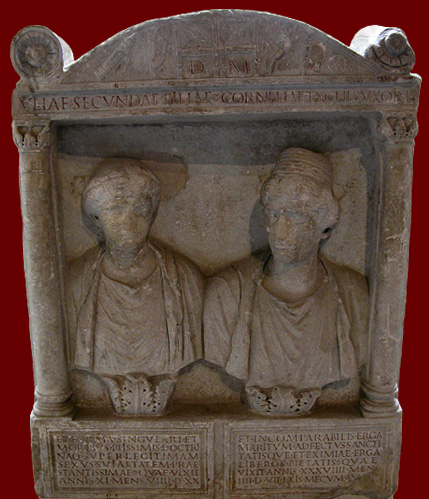
Marble Funerary Altar, early 2nd Century CE

Cornelia Tyche and her young daughter, Julia Secunda, are joined together on their tomb as they were in death. Judging from the size of their funeral altar and the quality and quantity of its memorial carving, the women belonged to a wealthy family if not an elite one (see the 16th century drawing of the monument, found intact in Rome's Campus Martius, later acquired by the Louvre). Their resources and perhaps status enabled the family to lavishly express its grief for the loss of mother and daughter. Their fate was described by Julius Secundus, paterfamilias and dedicator, in a 14-line Latin poem in dactylic hexameter, inscribed on one side of the altar -- their ship sank in a storm in the Gulf of Leon; their bodies washed up on the coast between Spain's Tagus and Hiberus rivers. The women may have been traveling to visit family, attend to family property, or even, given the age of Julia Secunda, to arrange a betrothal or a wedding. Their life-size portrait busts, set on acanthus-leaf bases in a niche between parallel Corinthian columns, dominate the altar front, which is all that remains of their tomb. Judging from their hairstyles, the women lived during the first half of the 2nd century CE. Cornelia Tyche wears her hair waved on the sides, with braids coiled high on top, in the familiar style of the Empress Faustina the Elder (94-141 CE), while Julia Secunda's hair is more simply parted in the center and pulled back in a bun at her neck, like that of the young Empress Faustina the Younger (129-175 CE). Cornelia Tyche wears the stola of the traditional matrona over her tunica (the left strap is visible), with her palla draped over her arms. Julia Secunda is dressed in a tunica, as befits a young girl, with her palla covering her shoulders. Named after the Greek personification of good fortune (whom the Romans worshipped as Fortuna), Cornelia Tyche's nomen and cognomen suggest that she was a freedwoman. Julia Secunda's cognomen, the feminized form of her father's, indicates that she was born after her parents were freed and could contract a legal marriage. For analyses of this monument, see articles by P. Williams and J. Huskinson in the Bibliography.
Above the portrait busts the monument is topped by volutes on either side of a curved shape whose inner space is closely carved on two levels. The lower "frieze" level contains the names of the deceased illuminated in red, each name identifying the woman below, with an ivy leaf between them. In the center of the upper "pediment" level stand two empty chairs in relief, with the letters D and M carved and illuminated under each seat. To the left of the chairs are a quiver and bow, symbols of the virgin goddess Artemis/Diana, who is frequently pictured on sepulchral monuments of young girls (also see Wood in Bibliography). To the right of the chairs in relief are symbols associated with, appropriately, the goddess Tyche/Fortuna: a cornucopia, torch, rudder, and wheel.

| IVLIAE SECVNDAE FILIAE | CORNELIAE TYCHES VXORIS |
Inscribed on panels beneath the niche containing the portrait busts are epitaphs corresponding to the deceased pictured directly above. Within the conventional formulas of praise, Julia Secunda and Cornelia Tyche are celebrated for excelling in those qualities esteemed in the filia and materfamilias. At the bottom right corner the stone is chipped, where Cornelia Tyche's years of marriage to her husband were proudly recorded. Scholars argue that there is only room for ANNIS X, which would have implications for Julia Secunda's status (either not freeborn or not the birthchild of Cornelia Tyche). Whatever the number, it is interesting to note that when Cornelia Tyche legally married Julius Secundus she would have been older than customary (27-8 years old), suggesting that s/he was enslaved until she reached that age or that she had been married before and widowed.

| ET FORMA SINGVLARI ET | ET INCOMPARABILIS ERGA |
| MORIBVS PIISSIMIS DOCTRI | MARITVM ADFECTVS SANCTI |
| NAQ[ue] SVPER LEGITIMAM | TATISQVE ET EXIMIAE ERGA |
| SEXVS SVI AETATEM PRAE | LIBEROS PIETATIS QVAE |
| STANTISSIMAE QVAE VIXIT | VIXIT ANNIS XXXVIIII MENS[ibus] |
| ANNIS XI MENS[ibus] VIIII D[iebus] XX | IIII D[iebus] VII EX [e]IS MECVM ANN[is XI] |
Click on the underlined words for translation aids and commentary, which will appear in a small window.